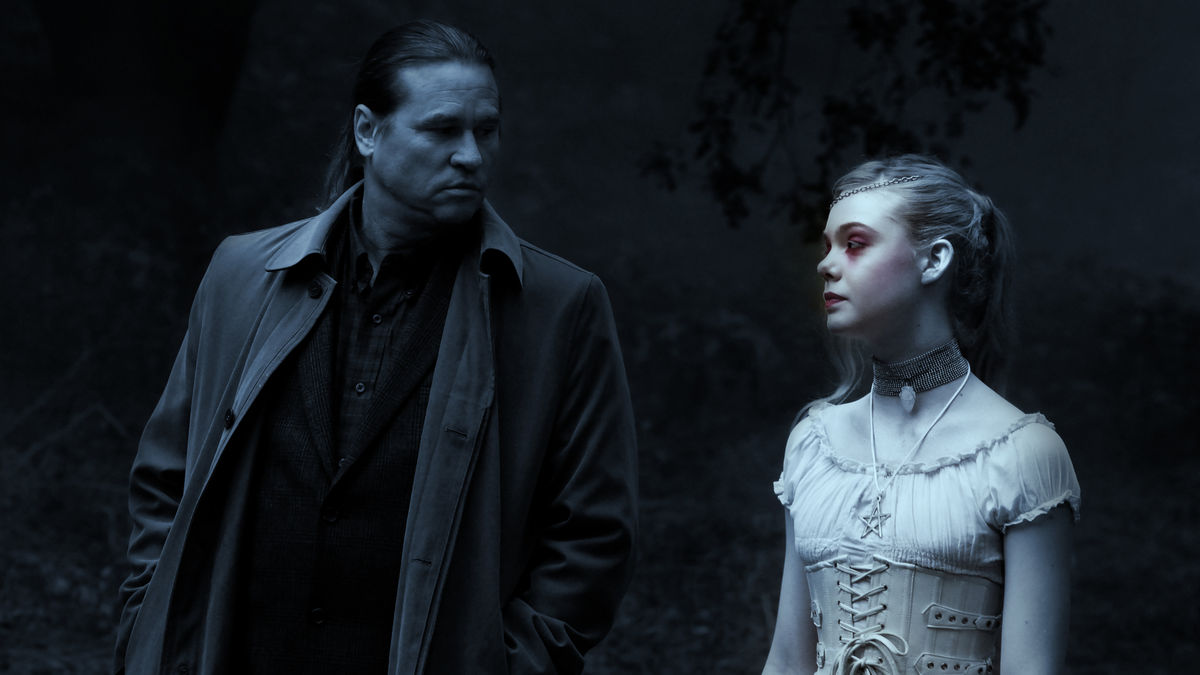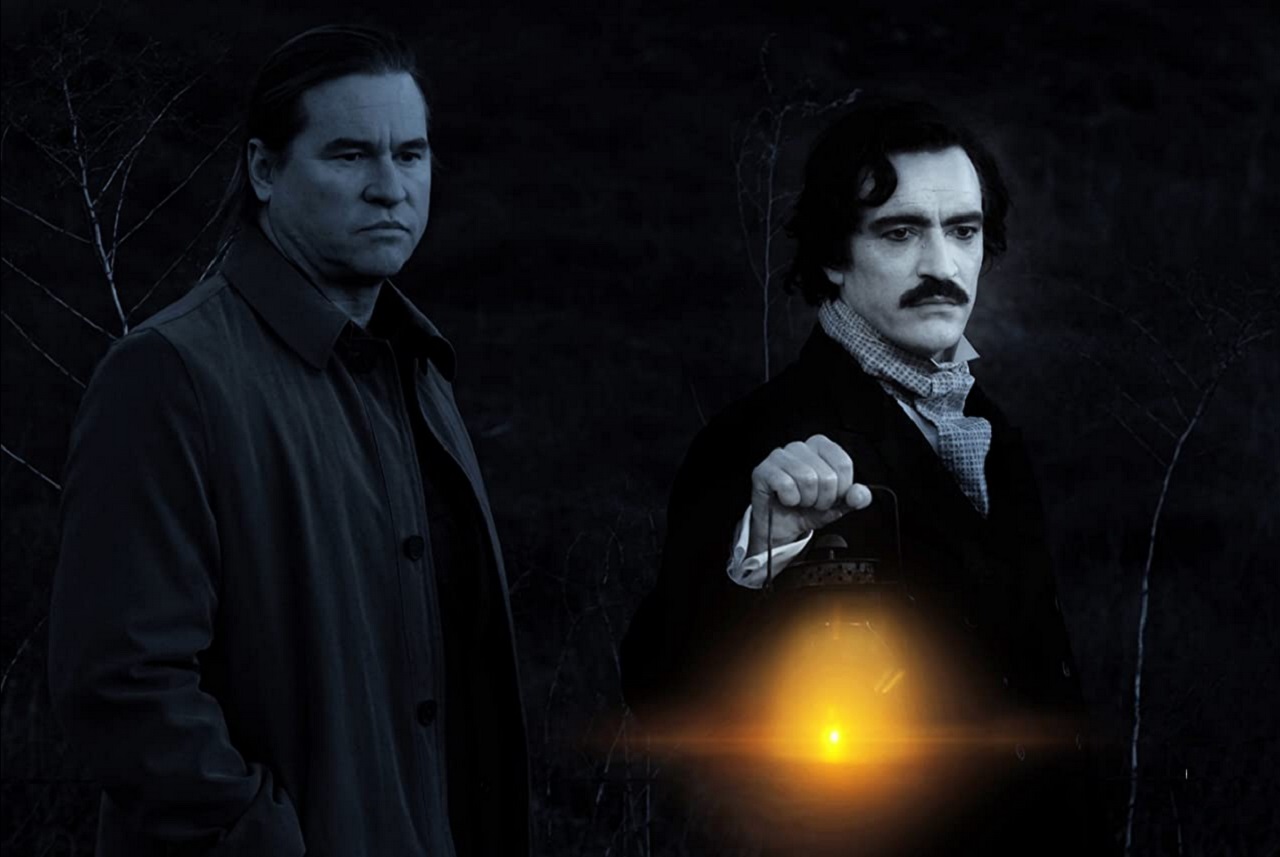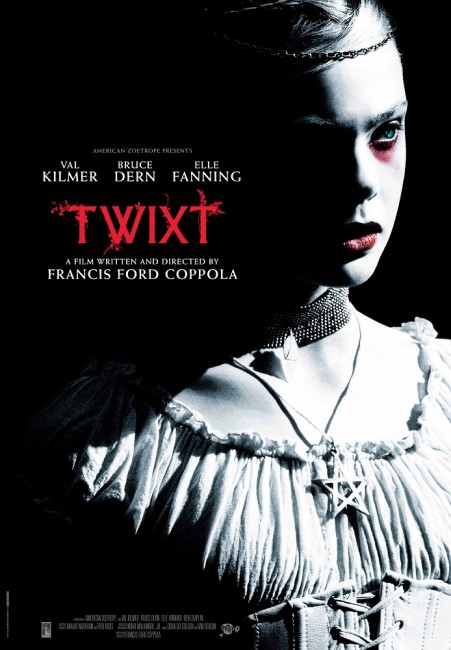USA. 2011.
Crew
Director/Screenplay/Producer – Francis Ford Coppola, Photography (some scenes 3D) – Mihai Malaimaire Jr, Music – Dan Deacon & Osvaldo Golijov, Visual Effects Supervisor – Viktor Muller, Special Effects Supervisor – Dick Wood, Makeup Effects – Aurora Bergere. Production Company – American Zoetrope
Cast
Val Kilmer (Hall Baltimore), Bruce Dern (Sheriff Bobby LaGrange), Ben Chaplin (Edgar Allan Poe), Elle Fanning (V/Virginia), Joanne Whalley (Denise Baltimore), Bruce A. Miroglio (Deputy Arbus), Anthony Fusco (Pastor Allan Floyd), Alden Ehrenreich (Flamingo), David Paymer (Sam Malkin), Don Novello (Melvin)
Plot
Struggling horror writer Hall Baltimore arrives in the sleepy nowhere town of Swann Valley on a book-signing tour. Sheriff Bobby LaGrange tries to persuade Hall that there is a story in the town and to collaborate with him on a book. He shows Hall a corpse at the morgue that has been staked through the heart. Hall has a dream where he meets a mystery young girl known only as V while walking through the woods. He comes to the old Chickering Hotel where the ghost of Edgar Allan Poe, who was once a resident, appears to him. He immediately decides that there is story potential there and starts to investigate. This takes Hall into Swann Valley’s buried past and in digging out the secrets of a series of vampire murders, the connection to a group of Goths and possible Devil worshippers who camp across the lake, the murder of twelve young girls in the care of a pastor, and how this connects to both his and Edgar Allan Poe’s past.
The name of Francis Ford Coppola should surely be on any list of the great American directors. Coppola was an essential gamechanger in 1970s cinema with the massive hits of The Godfather (1972), The Godfather Part II (1974) and Apocalypse Now (1979). At the same time as he was rising to the forefront of 1970s cinema, Coppola gained a reputation as a risk-taking maverick. In particular, his production of Apocalypse Now spiralled wildly out of control and over-budget. Throughout the 1980s, Coppola was making films of considerable brilliance and ambition – One from the Heart (1981), The Outsiders (1983), Rumble Fish (1983) and The Cotton Club (1984) – even when they were being middling box-office successes and financial flops that caused his American Zoetrope studio to eventually collapse into bankruptcy.
This maverick filmmaking took its toll on Coppola by the late 1980s and certainly into 1990s where he was being forced to make studio fare like Peggy Sue Got Married (1986), a disliked returned to the familiar with The Godfather Part III (1990), the mushy Robin Williams vehicle Jack (1996) and even a John Grisham adaptation with The Rainmaker (1997) to pay the bills. Coppola did have at least one standout return to glory during this time with his visually ravishing adaptation of Bram Stoker’s Dracula (1992) and has acted as producer on a number of other films. (See below for a full list of Francis Ford Coppola’s other genre credits).
Into the 2000s, after a decade of silence as director, Coppola marked a new direction with a series of low-key, independent films such as Youth Without Youth (2007), Tetro (2009) and Twixt here. Most of these have flown under the radar, received very mixed reception and done almost no box-office.

Twixt is a considerable oddity. Like Youth Without Youth, it is a film where you wonder what is going on in Francis Ford Coppola’s head these days. Both of these films seem less like the works of a mature master who made genuine American classics like The Godfather and Apocalypse Now than the works of a novice director just out of film school with a head full of pretensions and still not the language to coherently convey them to an audience.
Twixt is a sort of ghost story. Val Kilmer meets ghostly figures including a young girl (Elle Fanning) and Edgar Allan Poe (Ben Chaplin) who seem to lead him on a trail to solve a mystery about murders in the town and eventually reconcile with his own haunted past. Elle Fanning may or may not be a vampire and/or the ghost of Edgar Allan Poe’s lost love Virginia, or else one of the orphan girls killed by the reverend who used to live at the hotel. (It is not entirely clear what). There is also something to do with a group of Goths who live across the lake who are accused of devil worship by the locals – Poe insists they are innocent, although the leader of the group turns up in one dream sequence and would appear to be the one who put the vampire bite on Elle Fanning. The film reaches a resolution that makes nothing that has happened throughout terribly clear, even as to who conducted the vampire killings.
Coppola gives the film an interestingly haunted look. The dream sequences where Val Kilmer meets the ghostly Elle Fanning come in black-and-white with she an alabaster white and elements of the frame – the carpet of the hotel, its neon sign, the lit fire – tinted red or orange. This is interesting for a time; on the other hand, you keep thinking that Coppola did far more interesting things visually with Bram Stoker’s Dracula. There the entire screen seemed alive with ravishing and exciting cinematic possibilities; here the effects feels like the tricks someone might play in a novice arthouse film.

Crucially, Twixt never seems to go anywhere. You are not even sure if Coppola is trying to make a horror film. Certainly, there is very little that ever could be construed as scary or horrific in the film. The events seem to take a long time to go anywhere and hold no clear direction when they do.
In the lead role, Coppola casts Val Kilmer who is certainly looking a lot beefier and fuller in the face and is clearly on the sunset side of his days as a teen heartthrob idol back during the 1980s/90s. In one interesting piece of casting, Coppola brings Joanne Whalley out of the woodwork as Val Kilmer’s wife (seen on webcam). Of course, Kilmer and Whalley were a real-life husband and wife (from 1988 until a high-profile separation in 1996) and this interestingly marks what might be termed as reconciliation on screen for the two of them (albeit one that casts them as a bickering husband and wife).
Francis Ford Coppola’s other genre films are:– the re-edited Russian sf film Battle Beyond the Sun (1963); the psycho-thriller Dementia 13/The Haunted and the Hunted (1963); the leprechaun musical Finian’s Rainbow (1968); the time travel fantasy Peggy Sue Got Married (1986); Bram Stoker’s Dracula (1992); Youth Without Youth (2007) about a man who miraculously regains his youth; and the epic SF film Megalopolis (2024). Coppola has also produced work within the genre from George Lucas’s debut feature THX 1138 (1971), the alien visitor tv movie The People (1972), the ghost story Haunted (1995), the tv mini-series White Dwarf (1995) set on an alien world, Andrei Konchalovski’s epic mini-series version of The Odyssey (1997), the X Files ripoff tv series First Wave (1998), the Hawaiian supernatural revenge film Lanai-Loa: The Resurrection (1998), Agnieszka Holland’s Catholicism and miracles drama The Third Miracle (1999), Victor Salva’s Jeepers Creepers (2001) and Jeepers Creepers II (2003), and the eccentric Hal Hartley monster movie No Such Thing (2001).
Trailer here


